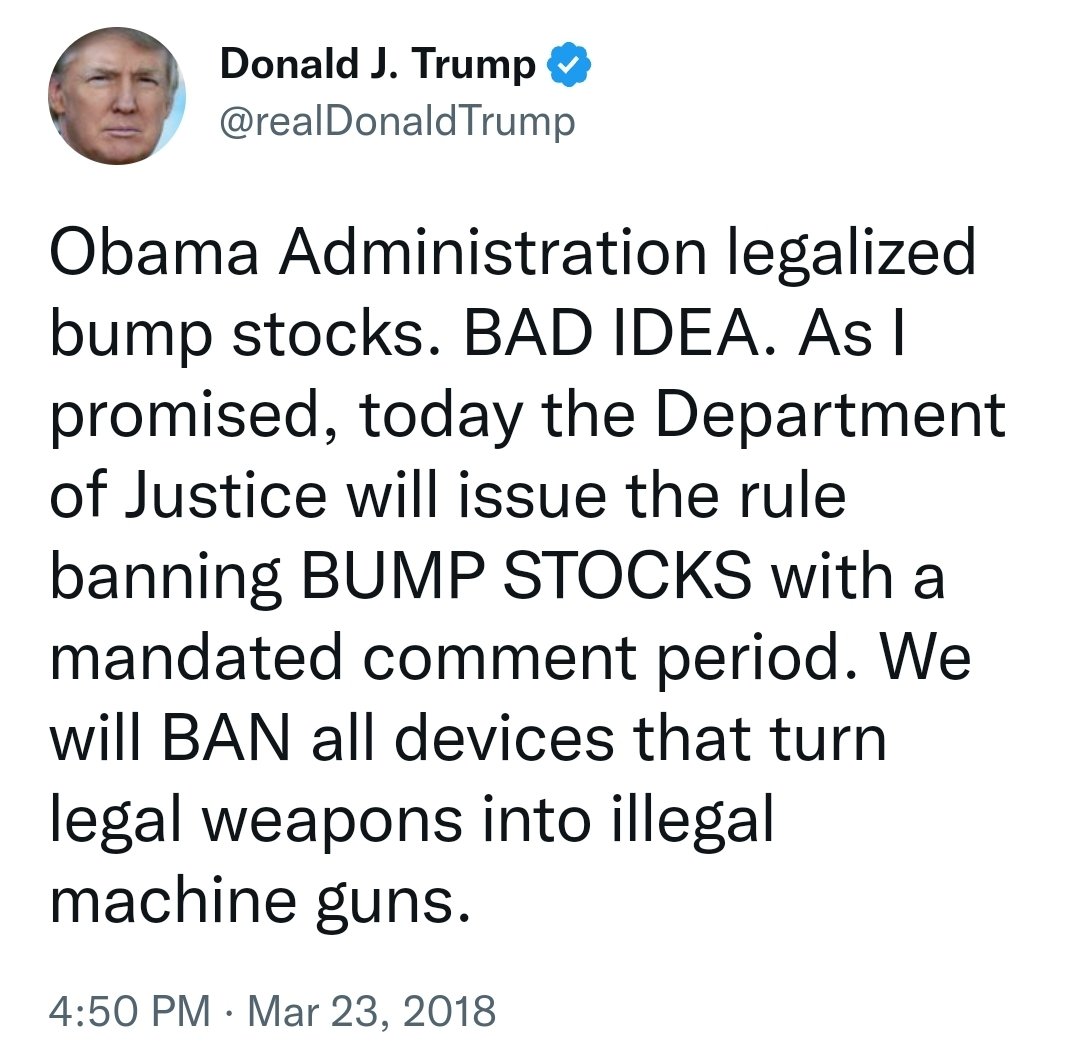The US Supreme Court announced Friday that it had decided to hear arguments on the controversial and seemingly unconstitutional Trump Administration outlawing so-called "bump stocks." The case, Garland v. Cargill, was added to the court's docket just a few days before the 2023-2024 term opens.
This case has its origins in the 2017 mass shooting at a music festival on the Las Vegas Strip that killed 60 people and wounded at least 413. While we may never show any more interest than the FBI in understanding why Stephen Paddock committed this atrocity, we do know that at least one of the weapons he used was equipped with a bump stock.
A bump stock is a device that harnesses the recoil of a legal semiautomatic rifle to pull the trigger instead of the shooter pulling it. It doesn't change the operating mechanism of the weapon.

In February 2018, President Trump declared that his administration would “dedicate all available resources to complete the review of the comments received, and, as expeditiously as possible, to propose for notice and comment a rule banning all devices that turn legal weapons into machineguns.”
Five months after the Las Vegas Shooting, Attorney General Jeff Sessions announced that the Trump Administration would ban bump stocks.
“Since the day he took office, President Trump has had no higher priority than the safety of each and every American,” said Attorney General Jeff Sessions. “That is why today the Department of Justice is publishing for public comment a proposed rulemaking that would define ‘machinegun’ to include bump stock-type devices under federal law—effectively banning them. After the senseless attack in Las Vegas, this proposed rule is a critical step in our effort to reduce the threat of gun violence that is in keeping with the Constitution and the laws passed by Congress. I look forward to working with the President’s School Safety Commission to identify other ways to keep our country and our children safe, and I thank the President for his courageous leadership on this issue.”

The bump stock ban has had three trips to federal appeals courts and experienced some rough sledding.
Gun Owners of America vs. Garland
In December 2018, Gun Owners of America (GOA) sued in the Western District of Michigan, asking for an injunction blocking enforcement. GOA lost at the District Court and appealed. A panel of the Sixth Circuit ruled in favor of GOA. The government appealed, requesting an en banc hearing. The full circuit split 8-8, leaving the trial court decision intact. You can find the Sixth Circuit decision at this link.
Guedes vs. BATFE
This case was filed in 2018 with the Firearms Policy Coalition as the lead plaintiff. Like the GOA, they asked for an injunction. The case was filed in the DC Circuit and heard by Judge Dabney Friedrich. They lost and appealed to the DC Circuit and lost there. In April 2019, they appealed to the US Supreme Court, which refused to hear the case. The case made it back to the DC Circuit, which rendered a final judgment in favor of the government in August 2022.
You can find the DC Circuit decision at this link.
Aposhian vs. Wilkinson
W. Clark Aposhian, head of the Utah Shooting Sports Council, sued for an injunction in March 2019. Aposhian lost at District Court. The Tenth Circuit ultimately upheld the bump stock ban. The Supreme Court refused to hear the case in October 2022.
You can find the Tenth Circuit decision at this link.
John Doe vs. Biden
This case comes from the Southern District of Illinois. The plaintiff alleges the BATFE decision was improperly issued under the Commerce Clause. The case failed at District Court, and a three-judge panel of the US Court of Appeals for the Federal District dismissed the case.
You can find the Federal Circuit decision at this link.
Hardin vs. BATFE
Scott Hardin, the owner of several bump stocks, challenged the BATFE's authority to regulate the firearm accessory. Hardin lost in district court but prevailed in the Sixth Circuit.
You can find the Sixth Circuit decision at this link.
Cargill vs. Garland
Guns rights activist Michael Cargill sued for an injunction in 2019 in the Western District of Texas. He lost at District Court and appealed to the Fifth Circuit. A unanimous panel ruled against him in December 2021. Cargill asked for an en banc rehearing, and it was granted.
The full Fifth Circuit ruled 13-3 that a bump stock can’t be regulated as an automatic weapon because it does not make a firearm fit the legal definition of such, and the BATFE has long agreed with that position. This is George W. Bush appointee Jennifer Walker Elrod writing for the majority.
A bump stock is a firearm attachment that allows a shooter to harness the natural recoil of a semi-automatic weapon to quickly re-engage the trigger after firing, enabling him to shoot at an increased rate of speed. When ATF first considered the type of bump stocks at issue here, it understood that they were not machineguns. ATF maintained this position for over a decade, issuing many interpretation letters to that effect to members of the public.
…
The Government’s regulation violates these principles [Editor’s note: the principle is making rules that fall within the plain reading to the statute]. As an initial matter, it purports to allow ATF—rather than Congress—to set forth the scope of criminal prohibitions. Indeed, the Government would outlaw bump stocks by administrative fiat even though the very same agency routinely interpreted the ban on machineguns as not applying to the type of bump stocks at issue here. Nor can we say that the statutory definition unambiguously supports the Government’s interpretation. As noted above, we conclude that it unambiguously does not. But even if we are wrong, the statute is at least ambiguous in this regard. And if the statute is ambiguous, Congress must cure that ambiguity, not the federal courts.
This is the state of play as the Supreme Court prepares to hear the case.
While most people are looking at this as strictly a gun control issue, I think the antipathy of the conservative wing of the Supreme Court to Chevron Deference and whether the Justice Department and BATFE's decision to declare a weapon equipped with a bump stock to be a machine gun is reasonable will play a huge role.
This case is not a slam dunk, but I think it is very close to being one.













Join the conversation as a VIP Member